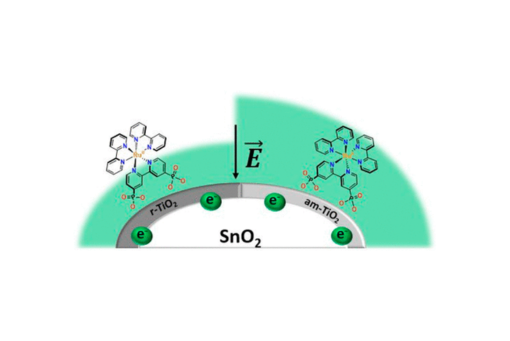Electroabsorption as a Probe of Electrons Injected into Nanocrystalline SnO2/TiO2 Core/Shell Thin Films
Abstract
Core/shell nanoparticles comprised of a SnO2 core and a TiO2 shell, SnO2/TiO2, present in a mesoporous thin film, are of practical interest for applications in dye-sensitized water splitting as they outperform sensitized materials based on SnO2 or TiO2 (anatase or rutile polymorphs) for the water oxidation half-reaction. Here we report electroabsorption studies designed to quantify the surface electric field and the ability of the shell to screen an electric field from a surface anchored dye. The metal-to-ligand charge transfer (MLCT) absorbance of [Ru(bpy)2(4,4′-(PO3H2)2-2,2′-bipyridine)](PF6)2, abbreviated RuP, was indeed sensitive to electron injection into the oxide support. When a fixed charge of 1 mC was injected, the electric field magnitude (in MV/cm) increased in the order 0.15 TiO2 (rutile) < 0.35 TiO2 (anatase) ≪ 1.4 SnO2 (rutile). This order tracks the reported bulk dielectric constants of the oxide materials. Comparative studies with SnO2/TiO2 core/shell materials, fabricated by atomic layer deposition (ALD) of a TiO2 shell on a mesoporous SnO2 thin film, diminished the field strength by about a factor of 4 to values less than or about equal to that measured for anatase TiO2. Heat treating some SnO2/TiO2 core/shell materials at 450 °C resulted in a crystalline rutile TiO2 shell that screened the field most effectively, more so even than rutile TiO2 alone. Taken together, the data indicate that injected electrons reside within the SnO2 core region.
Citation
Electroabsorption as a Probe of Electrons Injected into Nanocrystalline SnO2/TiO2 Core/Shell Thin Films
Erica M. James, Marc T. Bennett, and Gerald J. Meyer
The Journal of Physical Chemistry C 2023 127 (12), 5904-5910
DOI: 10.1021/acs.jpcc.3c00638


